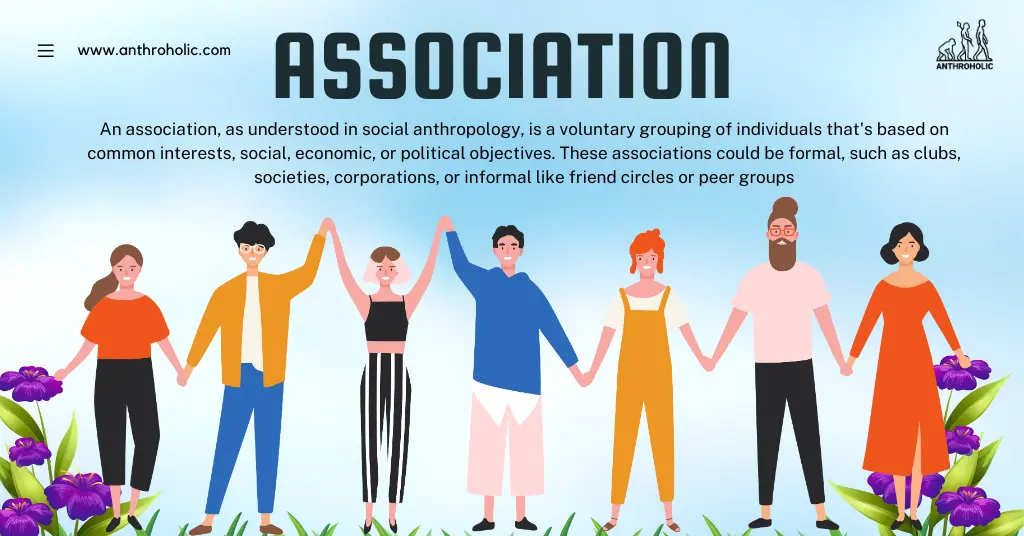AI Answer Evaluation Platform Live Now. Try Free Answer Evaluation Now
Association
An association, as understood in social anthropology, is a voluntary grouping of individuals that’s based on common interests, social, economic, or political objectives. These associations could be formal, such as clubs, societies, corporations, or informal like friend circles or peer groups [1].

- Formal Associations: These are structured groups with a formal set of rules, regulations, and often legally recognized. Examples include professional bodies like the American Anthropological Association, social clubs, political parties, and labor unions. These associations provide a structure for individuals to come together and work towards common objectives [2].
- Informal Associations: These are groups that come together based on shared interests, experiences, or cultural ties but without formalized rules or regulations. Examples include peer groups, hobby clubs, online communities, etc [3].
Importance of Association in Social Anthropology
Associations play a significant role in social anthropology for several reasons:
- Social Integration: Associations serve as a means of social integration, creating a sense of belonging among members and helping individuals feel more connected to their society [4].
- Social Control: They provide a structure that can guide individual behavior, contributing to social control.
- Cultural Transmission: Associations often facilitate the transmission of culture, beliefs, and customs from one generation to the next [5].
- Achievement of Common Goals: They enable people to come together to work towards common goals, allowing them to accomplish more collectively than individually.
How Associations are Studied in Social Anthropology
Social anthropologists use various methods to study associations, including participant observation, interviews, and surveys. They might focus on the following aspects:
- The structure and organization of the association.
- The shared beliefs, norms, and values within the association.
- The interactions between association members.
- The association’s influence on broader social systems and structures [6].
Role of Association in Social Change
Associations play a significant role in facilitating social change. They can serve as a catalyst for social movements, influencing public opinion, and enacting societal reform. For instance, associations like trade unions have played a crucial role in advocating for workers’ rights, resulting in substantial labor reforms [7].
Types of Associations in Social Anthropology
Anthropologists often categorize associations based on their attributes such as their objective, nature of participation, and level of formality. Here are some common types:
- Interest Associations: These groups are formed based on common interests or hobbies, such as book clubs or sports clubs [8].
- Occupational Associations: These include professional bodies or trade unions that are formed around a specific occupation or industry [9].
- Kinship Associations: These are formed based on kinship ties, such as clans or tribes [10].
- Cultural Associations: These groups are formed around shared cultural, ethnic, or linguistic identities [11].
| Type of Association | Primary Basis | Example |
|---|---|---|
| Interest Association | Common Interests | Book Club |
| Occupational Association | Professional/Occupational Ties | American Anthropological Association |
| Kinship Association | Kinship Ties | Clan or Tribe |
| Cultural Association | Cultural/Ethnic/Linguistic Identity | Italian American Association |
Associations and Social Network Analysis
Social anthropologists also employ Social Network Analysis (SNA) as a tool to study associations. SNA visualizes relationships and flows between people, groups, organizations, and other connected entities. This tool allows anthropologists to understand the structures of associations, the nature of relationships within them, and the roles of different members. SNA can also shed light on the impact of associations on broader social dynamics [12].
Case Study: The Role of Associations in Urban Development
Associations often play a crucial role in urban development, shaping how cities grow and evolve. For instance, neighborhood associations can influence local policy decisions, shaping aspects such as urban planning, housing, and public services. A study by Gittell and Vidal (1998) found that neighborhood associations in the United States played a significant role in improving local services and community development [13].
Conclusion
Understanding the concept of an association is crucial to understanding human societies and their cultural practices. It offers insight into how individuals collectively navigate their social world and can significantly contribute to our understanding of social integration, control, cultural transmission, and social change.
References
- Radcliffe-Brown, A. R. (1952). Structure and Function in Primitive Society: Essays and Addresses. London: Cohen & West. https://archive.org/details/structurefunctio00radc
- Barnes, J. A. (1954). Class and Committees in a Norwegian Island Parish. Human Relations, 7(1), 39-58.
- Whyte, W. F. (1943). Street Corner Society: The Social Structure of an Italian Slum. Chicago: University of Chicago Press.
- Durkheim, É. (2013 [1893]). The Division of Labour in Society. New York: Free Press.
- Hannerz, U. (1969). Soulside: Inquiries into Ghetto Culture and Community. New York: Columbia University Press.
- Barth, F. (1969). Ethnic Groups and Boundaries: The Social Organization of Culture Difference. Boston: Little, Brown.
- Fantasia, R. (1988). Cultures of Solidarity: Consciousness, Action, and Contemporary American Workers. Berkeley: University of California Press.
- Barth, F. (1969). Ethnic Groups and Boundaries: The Social Organization of Culture Difference. Boston: Little, Brown.
- Fantasia, R. (1988). Cultures of Solidarity: Consciousness, Action, and Contemporary American Workers. Berkeley: University of California Press.
- Radcliffe-Brown, A. R. (1952). Structure and Function in Primitive Society: Essays and Addresses. London: Cohen & West.
- Barnes, J. A. (1954). Class and Committees in a Norwegian Island Parish. Human Relations, 7(1), 39-58.
- Scott, J. (2017). Social network analysis. London: Sage.
- Gittell, R., & Vidal, A. (1998). Community Organizing: Building Social Capital as a Development Strategy. London: Sage Publications.




